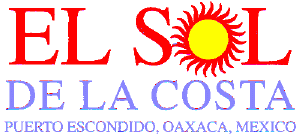

The traditional fiesta is a mixture of the sacred and the profane; solemn religious ceremonies in honor of the town's patron saint share the stage with more earthly entertainments.
The fiesta normally begins with a festive procession that is intended to announce the upcoming festivities, animate the townspeople and invite everyone to participate.
El convite takes place in the late afternoon. Lead by the town band, the participants, dressed in their finest fiesta clothing, pass through the main streets accompanied by larger-than-life huge papier-mache puppets.
After nightfall, they hold the calenda, a similar parade, but with the addition of faroles, colorful lanterns of candles inside paper globes. The revelers make frequent stops at all the main intersections to dance, fire off rockets and drink mescal or tepache. Sometimes the women carry decorated baskets of flowers or local produce.
On the night before the actual saint's day, and for many the highlight of the costeña fiesta are the fireworks, in particular the lighting of the castillo, or "castle", which is actually a cane or wooden tower rigged with fireworks to light up in a wondrously choreographed display of pyrotechnical magic.
The cohetero, "rocket maker", also creates los toritos, "little bulls", effigies of bulls and other figures, carried on the head and shoulders of local youths as they rush around the square in a loud explosion of fire and smoke. It's quite a show, unlike any fireworks display you've ever seen.
Other essential ingredients are the Jaripeos, bull-riding rodeo contests so popular throughout the region. These are often local affairs where young men show their grit, but sometimes they are high-stakes tournaments attracting professional riders.
There is often an event to select and crown the Fiesta Queen, all manner of sports contests, horse races, and, sometimes, cock fights. There are dances with touring bands with their tons of sound equipment and bazaars featuring itinerant merchants hawking all manner of goods and carnival rides.
All these activities take place to the accompaniment of the typical
regional band, comprising a brass section and a percussionist or two.
They play a distinct kind of music known as chilena.
(Note: If you would like to learn more about any of these activities, check
out the archives where these subjects are covered in greater depth.)
It is a bustling community of some 30,000 people built on cattle raising, limes, peanuts and copra production. The town's major fair of the year salutes the area's cattlemen and celebrates its patron saint, the Virgin of Guadalupe, the patrona of all of México, whose feast day is normally observed on December 12.
When Rio Grande was a tiny settlement, originally known as Piedra Parada, after the ancient Mixteca stone carvings found there, the circuit priests were just too busy officiate there in December. So it was decided the town would observe its feast day on May 12 instead.
The fair is couple with a huge Cattle and Agricultural Expo with elaborate rodeos, demonstrations of equestrian skills, horse racing and a big-money cock fight tournament.
There are actually two La Barras, facing each other on opposite banks of the Colotepec River as it runs into the ocean. La Barra de Colotepec, a village of about 2,000 inhabitants, sits on the west bank, closest to Puerto Escondido. The other is called Barra de Navidad (where you can tour the nearby lagoon).
Bajos de Chila also embraces San Isidro as patron saint and will hold observances during those same days even though Chila's major annual fair takes place around St. Valentine's Day in February.
Chila lies west of Puerto Escondido on the road to Manialtepec Lagoon.
Other community fiestas for San Isidro include: San Francisco Cotzoaltepec and San Isidro Pochutla, on the coast highway east towards Pochutla and San Isidro Nopala, which lies on the Sola de Vega highway to Oaxaca.